 Project 670/670M Skat: 17 SSGNs Nuclear powered Missile Attack submarines (Charlie I/II).
Project 670/670M Skat: 17 SSGNs Nuclear powered Missile Attack submarines (Charlie I/II).Soviet Cold War Subs
Pr.613 Whiskey | Pr.611 Zulu | Pr.615 Quebec | Pr.633 Romeo | Pr.651 Juliet | Pr.641 Foxtrot | Pr.641 buki Tango | Pr.877 KiloPr.627 kit November | Pr.659 Echo I | Pr.675 Echo II | Pr.671 Victor I | Pr.671RT Victor II | Pr.671RTMK Victor III | Pr.670/670M skat Charlie | Pr.705 lira Alfa | Pr.949 antey Oscar | Pr.945 Sierra | Pr.971 bars Akula | Pr.885 graney Yasen | Pr. 545 Laika
Pr.629 Golf | Pr.658 Hotel | Pr.667A Yankee | Pr.667B Murena Delta I | Pr.667D Delta II | Pr.667BDR Kalmar Delta III | Pr.667 BDMR delfin Delta IV | Pr. 941 akula Typhoon | Pr.995 borei Dolgorukiy | Pr.09851 Khabarovsk

The Project 670 Skat submarine (NATO Charlie class) were nuclear-powered cruise missile submarine (SSGN) of the Soviet Navy and later Russian Navy, now all decommissioned. They were designed by the Lazurit Central Design Bureau of Gorky in order to replace the previous 1950s Echo I and II SSGNs. The Charlie I used the P-70 stopgap missile as the planned P-120 (installed on the Charlie II) was not ready due to complex engine issues. These models intriduced many innovations. They were smaller than the ECHO class they replaced, had a single propeller, and far better noise reduction compared to previous boats. Amazingly also, they were built well inland at Gorky, and had to ferried by rivers to the sea. In all 17 were made between the two classes. Both could launch their missiles sublerged, an immense advantage, but had to return to port for reload and still possessed six torpedo tubes and 16 torpedoes in addition. If the last “Charlie” was retired in 1994 one was leased from 1988 and 1991 to India as Chakra, to gain experience in nuclear submarine operation, playing a crucial role in the development of Indian nuclear submarine program today.
Development
In 1959 already work started in USSR to create a 2nd generation nuclear submarines, intended for mass production production and tailored to destroy aircraft carriers, as well as other large enemy ships. There were a number of proposals from design bureaus for a relatively simple and cheap nuclear submarine. This became the basis for Project 670 Skat, a new type of submarine optimized for striking surface targets, presumably armed with missiles. The TTZ was issued to Gorky SKB-112 (which from 1974 became TsKB Lazurit) in May 1960.
The main difference between Project 670 and 1-generation SSGN of the ECHO class was their new P-70 Amethyst anti-ship missile system and underwater launch. The government decree for the creation of the Amethyst complex was issued on April 1, 1959. The goal was ambitious in scope and trigerred scores of problems to create the new SSGN already (notably the price, simplifications, and underwater launch), but it as compounded by a purely political decision, of a construction made in Gorky, at the very center of Russia. This was 2000 km from the nearest sea. This imposed right away a monumental sets of limitations regarding size and displacement within the limits allowing of inland waterways.
As a result, designers had to think outside of the box and find many new unconventional solutions contradicting the “Rules for Designing a Submarine.” In particular, switch to a single-shaft design, sacrifice surface buoyancy in case of flooding any watertight compartments were necessary sacrifices within the framework of a preliminary design, and the end result was a SSGN which normal displacement was 2400 tons at first but rhrough 1960s revision was to exceed 3000 tons.
Compared to other 2nd generation subs designed around the new hydroacoustic complex “Rubin”, the Project 670 Skat could pnly be fitted with the much smaller and less capable sonar system “Kerch”.
Approval of the technical design (TTZ) was awarded in July 1963.
Design of the class
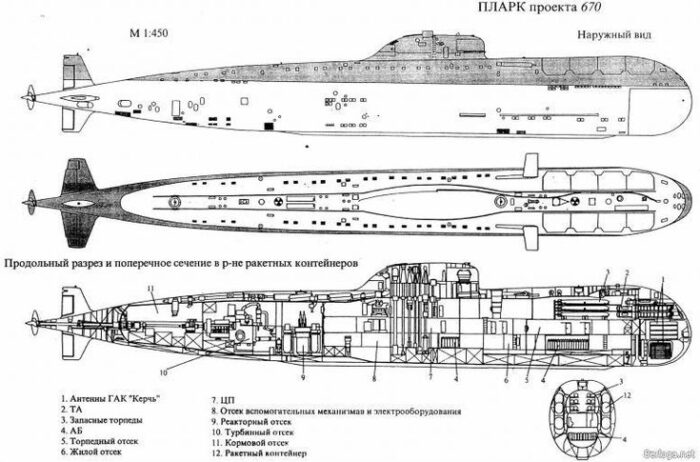
The Charlie class invited many changes and innovations in Soviet submarines design. They were notably the first with a single propeller, the first with a clearly “teardrop” shape, 10 years after the US, the first with a better sonar arrangement forward, but still retaining their forward torpedo tubes. Overall, they were much smaller than the Echo II (5,760 long tons submerged) versus 4,900 tons for the Charlie I with the same number of missiles (8).
Hull and general design
The use of large-sized hydroacoustic systems and to provide the best detection arc aft pressed a redesign of the bow, much more rounded. Some sensors and systems had to be placed in the upper part of the bow in the outer hull. Front horizontal rudders were relocated amidships to fre internal space forward as well. Later, during their first modernization, an hydrodynamic stabilizer was installed in front of the retractable sail masts, with a negative angle of attack to compensating for the excessive buoyancy of the enlarged bow.
The ship’s pressure hull was made of AK-29 steel. The prominent bulbous bow, 21 m wode, had a a peculiar “triple eight” shape, formed by cylinders of relatively small diameter, due to the need to accommodate missile containers in a lightweight body.
The hull was divided into seven waterproof compartments: 1st in three cylinders, torpedo, residential and battery, 2nd (residential, 3rd (central post and battery), 4th (electromechanical), 5th (reactor), 6 (turbine) and 7th (electromechanical).

1 -main antennas SJSC “Kerch” sonar
2 -533 mm Torpedo Tubes
3 – circular navigation detector (NOC)
4 -anchor capstan
5 -torpedo loading hatch
6 -spare torpedoes
7 -bow emergency buoy
8 -bow (missile and torpedo) compartment
9 -Firing Post “Amethyst”
10 -bow trim tank
11 -annular gap tank (post-fire trim control)
12 -torpedo replacement tank
13 -central urinary tract
14 -bow group AB
15 -bow horizontal rudder
16 -second (living) compartment
17 -VSK mine
18 -VVD cylinders
19 -equalization tanks;
20 -third (central) compartment
21 -stern group AB
22 -periscope PZNS-10
23 -“Topol” antenna, communication complex
24 -antennaradio direction finder “Veslo-P”
25 -radar antenna post
26 -RCP
27 -SORS antenna “Zaliv-P”
28 -laying trench PMU Topol antennas
29 -central post
30 -fourth (auxiliary mechanisms) compartment
31 -trim Tanks feed water system
32 -5th reactor compartment
33 -reactor
34 -steam generators
35 -tanks biological protection
36 -sixth (turbine) compartment
37 -cadets room
38 -tank turbine oil
39 -aft hatch;
40 -aft compartment
41 -diesel fuel tank for diesel generators)
42 -drives and stern rudders
The outer hull, ballast tanks and pressured conning tower were made of low-magnetic steel and AMG, whereas the the superstructure and sail of the retractable wheelhouse were made of aluminum alloy. Titanium alloys was used for the hydroacoustic antennas radomes, as well as in the aft end submerged section at at stern tails. The use of such dissimilar materials which in some cases forming galvanic couples, forbade the use of anti-corrosion protection measures, notably zinc protectors, gaskets, and others.
To reduce hydrodynamic noise at high speed, and improve hydrodynamic characteristics, the closing of scupper and ventilation openings was done by shutters to reduce any chances of bubble production. This was another innovation.
Powerplant

Project 670 Main power plant was rated for 15,000 hp. overall. It was twice as powerful as Project 671 Ersh SSNs (Victor class) which had a single-reactor. The OK-350 complex included a VM-4 water-cooled reactor rated for 89.2 mW. The single turbine GTZA-631 drove a five-blade propeller (later, a new low-noise twin 4-blade propeller 3.92 and 3.82 m wide was installed in a new tandem configuration). There were two auxiliary waterjets powered by electric drive (270 kW each) for manoeuvers up to 5 knots.
The hydraulic system was divided into three autonomous subsystems for all devices, lift the missile container covers and activate the rudders. During operation, the working fluid was a constant headache as being a fire hazard until replaced with a new, less flammable one during modernizations.
The Charlie class had a Buoyancy reserve of 24%, a working diving depth at 240 m and a maximum diving depth at 300 m. If the fully submerged speed was limited to 26 knots, surface speed was maintained at 10 knots. It had an autonomy of 60 days, but unlimited range. Unlike SSBNs it was not envisioned to give them two rotating crews of 86.
Stealth
Measures to reduce her acoustic signature included soundproofing damping in the foundations of the turbine, shaft, reactor, as well as lining bulkheads and decks with vibration-damping coatings to even mask the fall of an object or foot noises. All external surfaces of the outer hull, superstructure and enclosure were lined with rubber anti-hydrolocation coating. The outer surface of the pressure hull also for the first time had a similar coating. Thanks to this and the single-shaft, single-turbine layout, the Charlie class had a much reduced level of acoustic signature at the time, and create a new puzzle for US sonar crews. At full speed, the noise level in ultrasonic frequency range did not exceed 80 decibels, and in audio range 110 decibels, in infrasonic range 100 decibels, and most acoustic range coincided with natural sea noises. To reduce magnetic signature, a demagnetization system was mounted as well.
Other perks
Compared to the 1st generation SSGNs, the level of automation on Project 670 Skat was sharply increased. Control in depth and heading, pitch, diving and ascent, as well as preventing emergency trims and managing preparations for missile and torpedo firing were now all fully automated. All was neatly displayed on a few consoled in the Central Operation room behind the conning tower.
Habitability was improved also with a reduced personnel, provided with individual sleeping accommodations. Wardrooms were created for officers and a proper dining room for sailors and midshipmen. Interior design has been improved with rubber floors, internal insulation panelling masking all the piping and cabling, and fluorescent lamps with various lighting modes depending on stations and emergencies.
Armament
The Charlie Is had two banks of four missile tubes, all angled upwards, on each side of the bow, in the outer hull. The tubes hard large outer doors opened hydraulically (which forced to reduced underwater speed to avoid cavitation). These were tailored for the complex P-120 Malakhit (NATO SS-N-9 Siren) which were medium-range anti-ship missile only made to attack large US ships. Due to delays in missile development from 1959, the shorter range P-70 Ametist (SS-N-7 Starbright) were subsititued for the first years of service. These were still submerged when launched, but a development of the older, obsolete P-15 Termit (SS-N-2 Styx). These quiet subs were tactically designed for “pop up” surprise attacks on US aircraft carriers essentially. They were on paper out of range even of the furthest extent of escorts sonar range.
Project 670 SSGN missile armament of eight anti-ship missiles was located in SM-97 container launchers forward outside the pressure hull, angleed at 32.5°. In 1977, the first Amethyst anti-ship missile firing tests took place.
P-70 Ametist (SS-N-7 Starbright)
The P-70 was designed as an improvement over the P-5 Pyatyorka (SS-N-3 Shaddock) launched by Project 659 submarines (ECHO I) which obsliged them to spent at least 30 minutes surfaced when firing making them quite vulnerable to spotting and attack. A replacement was initiated in 1959 for a new model launched whilst submerged which became the P-120 Malakhit for Project 670 submarines.
However, it had complex engines for long range and this forced to adop as stopgap, the P-15M Termit (SS-N-2C ‘Styx’) for the first batch (Charlie I) which became the P-20L, later P-70 Amethyst.
It could be launched from under 30 m (98 ft). It used for guidance an L band active radar homing sensor and new radar altimeter developed for the P-120, but being smaller, it had no datalink but folding wings. Its short range and absence of mid-course updates were a problem. It entered service from June 3, 1968 and About 200 were produced.
The P-40 (4K-66) solid fuel missile had a launch weight of 2900 kg, max range of 80 km with unfolding wings after launch. Its low altitude made it difficult to be detected and intercepted by air defense systems. Its RCC radar homing system ensured automatic target selection in order of the largest reflective surface. A Charlie I typically had two missiles with nuclear warheads, six conventional and usually was launched in four-missile salvoes from 30 m at 5.5 knots, in a sea state up to 5 points.
⚙ specifications P-70 Ametist (SS-N-7 Starbright) |
|
| Weight | 7,700 lb (3,500 kg) |
| Dimensions | 23 ft (7 m) |
| Propulsion | Solid fuel |
| Speed | Mach 1 (1,160 km/h) |
| Range | 65 km (35 nmi) |
| Guidance | L band active radar homing sensor, radar altimeter |
| Ceiling | 50-60 m |
| Accuracy | Unknown |
| Payload | 1,170 lb (530 kg) High explosive/200 kiloton nuclear |
P-120 Malakhit (NATO SS-N-9 Siren)
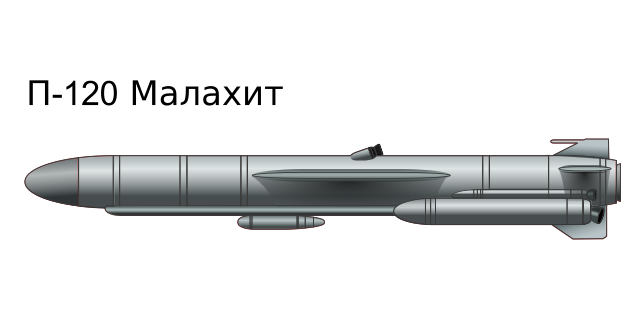
The P120 planned from 1959 was much delayed and only entered service with the Charlie II class submarines. The new missile had an L band seeker and radar altimeter originally designed for it but used instead on the stopgap ‘Starbright’ seen above. Its troublesome engines were fixed and it was large enough for a datalink equipment allowing mid-course guidance for over the horizon accuracy and ha a terminal homing system. It could be launched also from under 50 meters, versus 30 with the Starbright. It entered service on corvettes from March 17, 1972, the Nanuchka and later Sarancha class and of the course the Charlie II from November 1977. About 500 were produced. They were six fitted with a conventional warhead and two with thermonuclear warheads to give that option at all times. It saw action in 2008 with the Black Sea Fleet (action off Abkhazia) but without success against MV Lotos-1 from Moldova.
⚙ specifications P-120 Malakhit (NATO SS-N-9 Siren) |
|
| Weight | 3,180 kg (7,010 lb) |
| Dimensions | 8.84 m x 76.2 cm x 2.1 m (29 ft x 30 in x 6.9 ft) |
| Propulsion | Turbojet, solid fuel |
| Speed | Mach 1+ |
| Range | Conventional warhead 70 km, nuclear 110 km |
| Guidance | L band radar, datalink, active homing |
| Payload | 840 kg (1,850 lb) HE 500 kg/1102 lb HE-SAP or 200 kt nuclear |
Torpedo Tubes
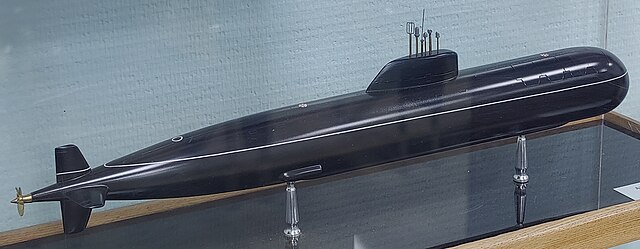
The Charlie still had their six bow torpedoes tubes. They carried six 533 mm in reserve, 12 total, for active hunting when not using their missile. One theory as they were quite discreet was to be combined in a “wolfpack”, furing a coordinated missile strike from different angles to overwhelmed the carrier group defences and then close in for a final torpedo attack and finish off crippled ships of possible. The soviet naval staff knew indeed of the great degree of resilience of carriers and damage control mastery of the crews.
There were four 533 mm 53-65k or SET-65 torpedoes (12 torpedoes) were likely of the SET-53M type, completed by two 400 mm (2 in tubes, 2 in reserve) with moslty decoy torpedoes.
Their types could have been also at this date the following models:
53-65M (1969):
Acoustic wake following homing torpedo derived from the 53-61 torpedo.
Weight 4,630 lbs. (2,100 kg), 283 in (7.200 m) long, warhead 661 lbs. (300 kg).
Range/Speed 24,000 yards (22,000 m)/44 knots, powered by a Kerosene-Hydrogen Peroxide Turbine.
TEST-68 (1969):
First Russian wire-guided torpedo, derived from SET-53M. Active/passive acoustic homing 880 yards. Capable of 650 feet (200 m).
Weight 3,307 lbs. (1,500 kg), lenght 311 in (7.900 m), 220 lbs. (100 kg) warhead. 15,300 yards (14,000 m)/29 kts, Silver-zinc battery.
An alternative to torpedoes were the AMD-1000 mines, of which 24 could be carried.
400 mm SET 40
Developed by NII-400 Gidropribor and produced from 1965 to the 1980s by Dvigatel, the nsame stands for Spetsialnaya Elektricheskaya Torpeda 40, “special electric torpedo 40”.
Factory name was MGT-2, Type 40 in NATO classification or Izdeliye 241 in GRAU index.
These lightweight torpedoes were developed for submarines against enemy submarines. They were derived from the 400mm MGT-1 lightweight torpedoes tailed for small surface vessels, here, redesigned to hunt down submarines. These torpedoes were composed of a sensor, warhead, battery and engine compartments, single propeller, silver-zinc batteries (seawater activated) and combining active and passing homing, 600 to 800 m range. The Charlie likely operated the SET-40U with the Sapfir sensor.
Range was 8 km at 29 knots. They had a 80 kg warhead set off by an acoustic proximity fuse but the advanced SET-40U had a backup contact fuse.
The model was further modernized as the SET-40UL (Lotsman captive torpedo naval mine system) of 1970 and SET-40UE for export in 1975.
In addition, the torpedo ammunition also included Anabar decoys.
Sensors
The main navigation system was the Sigma-670 complex, which accuracy were 1.5 times higher than the 1st generation boat’s systems.
The main sonar was the Kerch hydroacoustic complex capable of a range of up to 25 km.
The BIUS “Brest” fire control system was used to control the torpedoes.
Active Protection
SSGN “670 Skat” had a stationary electrolysis air regeneration system for the crews. It enable to discard dangerous regeneration cartridges, a deadly fire hazard. Effective fire fighting comprised also a volumetric freon fire extinguishing system.
They were considered the safest SSGNs in Soviet service, and on 11 Project 670 (Charlie I) built between 1968 and 1973 only K-429 sank near Petropavlovsk-Kamchatsky in 1983 with 16 fatalities. She was raised and used as harbour training hulk. On 13 September 1985, K-429 sank at her moorings due to either human error or maintenance issues. She was raised and decommissioned. See the logs for more details.
⚙ Project 670 (Charlie I) |
|
| Displacement | 4,000 tons standard, 4,900 tons submerged |
| Dimensions | 95 x 10 x 8m (312 ft x 32 ft 10 in x 26 ft 3 in) |
| Propulsion | Pressurized water-cooled reactor, 2 steam turbines: 11,185 kW (14,999 shp) |
| Speed | 20 knots (37 km/h; 23 mph) surfaced, 24 knots (44 km/h; 28 mph) submerged |
| Range | Unlimited except by food supplies |
| Armament | 6× 533 mm (21 in) TTs (12 torpedoes), 8x P-70 Ametist SSNs. |
| Max depth | 300m+ |
| Sensors | Sigma-670, Kerch complex, Brest FCS |
| Crew | 100 |
Project 670M (Charlie II)


Charlie I and II for comparison, both profiles by Mike1979Russia, CC
In 1972 to 1979, six improved units Project 670M Skat-M (Charlie II) boats were built also at Gorkiy. They had a 8 m (26 ft 3 in) additional insert in the hull forward of the fin to incorporate electronics and launch systems for larger, longer range P-120 Malakhit anti-ship missile.
⚙ Charlie II specifications |
|
| Displacement | 4,300 tons standard, 5,100 tons submerged |
| Dimensions | 103 m (338 ft). Same beam and draft. |
| Propulsion | Same |
| Speed | Same |
| Range | Same |
| Armament | Same and 8x P-120 Malakhit SSNs, 24 AMD-1000 ground mines. |
| Crew | 98 |
Charlie I in service
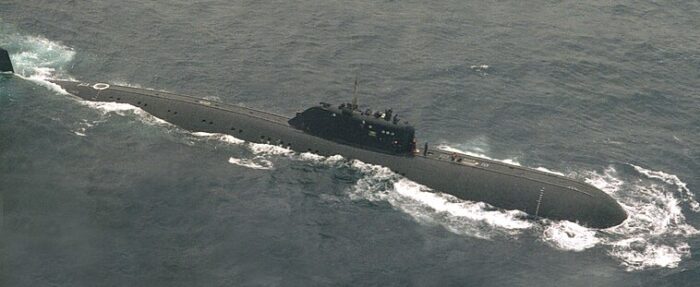
After transportation on a dedicated floatingdock along the Volga, through the Mariinsky water system and White Sea-Baltic Canal, these boats were transferred to Severodvinsk, where they were completed, tested and delivered to the Navy. It should be noted that at the initial stages of the program, the option of having these sent to the Black Sea was considered. However it was rejected for geopolitical reasons, the notorious problem of the Black Sea Straits and constant doubt about the nature of their missiles.
The acceptance certificate for the lead ship K-43 was signed on November 6, 1967, just at the eve of the 50th anniversary of the Great October Revolution. First commander was Captain 1st Rank E.N. Zolotarev. On July 3, 1968, after K-43 tests, the Amethyst missile system was adopted and she became part of the 11th division, 1st submarine flotilla, Northern Fleet. Later, the remaining Charlie I were assigned to this unit. They started service in 1972, monitoring US Carrier Battle groups and took part in various exercises and maneuvers, notably “Ocean-75”, “Sever-77”, “ Run-81” and others.
On the west, the appearance of new, discreet and better equipped missile submarines complicated life for US aircraft carrier formations. The SSGN “Charlie” not only escaped detection for a time, but their underwater launch was much more effective. CBGs had far less margins for reaction. The relatively low range of the Amethyst however requioed to approached at 60-70 km, well within the range of carrier-borne ASW patrol planes such as the S3 Viking. However the advantage was an even shorter flight time at low-altitude missiles and thus much reduced counteraction tim until the strike. In Russian this was called the “dagger stab”.
One of the main areas where Project 670 ships were expecially efficient was the Mediterranean Sea. In the 70-80s, both superpowers had interests intertwined there. Charlies were engaged thus against the 6th American Fleet which generally always had two CBGs rotating in operations, and sometimes, three with a relief. The geographical conditions of the Mediterranean made these SSGNs even more formidable adnd their presence, once confirmed, caused well-founded concern in the American command, which lacked adequate answers. The Spruance class just entered service but the OH Perry were still awaited. In May 1972 one boat, K-313 made a spectacular demonstration when firing at a practice target and sink it at large distance, under captain 2nd rank S.Ya. Zgursky.
Gradually, North Sea boats expanded their operation area, by January-May 1974, K-201 made a 107-day (Capt. 2nd Rank V.D. Khaitarov) with K-314 from the Northern to the Pacific Fleet along the southern route through the Indian Ocean. On March 10-25, they stopped at Berbera (Somalia) for R&R, after which the voyage continued to Kamchatka by early May.
In April 1977, K-429 (Captain 1st Rank V.T. Kozlo, RADM E.D. Chernov) made an underice cruise on the Northern Sea Route to the Pacific Fleet and on April 30, 1977, entered the 10th Division of the 2nd Submarine Flotilla in Kamchatka.
In August-September 1979, another 20 days under ice cruise was done by K-302 (Captain 2nd Rank M.A. Mazhugo). K-43 (1980), K-121 (until 1977), K-143 (1983), K-308 (1985) and K-313 all arrived in the Pacific Ocean. The only alternative route was through the Suez canal or even the cape.
Incidents
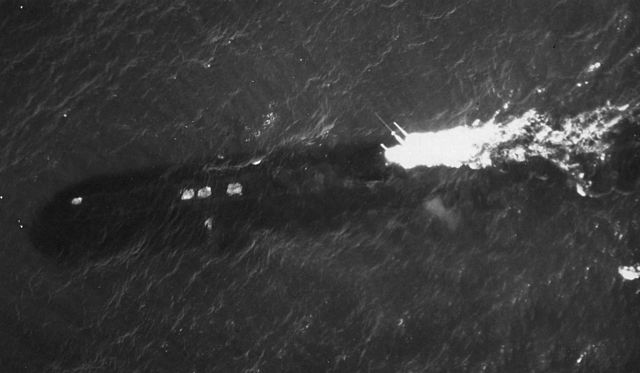
All “Pacific” boats were in the 10th division of the 2nd submarine flotilla. Their main task was to shadow US CBGs from the 7th fleet. K-201 in December 1980 carried out a very long tracking of a USN strike group led by USS Coral Sea. Due to the shortage of SSGNs in the Pacific Fleet, they also looked for threars for present patrol areas of Soviet Pacific SSBNs. But they had problems, and if less acute that 1st generation SSNs they were still nicknamed in the Soviet Navy the “darlings of fate” and “unlucky ones”.
K-429 was perhaps the least fortunate. On June 24, 1983, the crewmember on board bottched a trimming manoeuver and the boat sank at the combat training site in Saranaya Bay with onboard which went down with her. Her raising was complicated, her restoration very costly and she sank a seocnd time, this time, not restoration was done and she was converted as a fixed training station.
Other incidents, less serious (no loss of life) included:
-Flooding of the 2nd compartment of K-313 while in base in August 1970.
-Partial flooding of three compartments through the ventilation system on K-313 again, when submerged on August 8, 1971.
-Collision of K-320 and K-131 in Motovsky Bay, January 19, 1972.
-Grounding in Motovsky Bay for K-302 in June 1972.
-Partial flooding of the reactor compartment on K-320, 1973.
-Partial flooding of the reactor compartment on K-429, March 1973.
-Fire in cabling in the turbine compartment on K-325, December 22, 1973.
-Grounding at depth 130 m by K-302 in February 1974.
-Tug hit by accidental missile fire by K-25 in May 1974.
-Destroyed ballast tank No. 13 during blowing on K-429, 1975.
-K-201 caught in Japanese fishing nets near Kamchatka on October 8, 1977.
-Collision between K-313 and MPK-90 in Zapadnaya Litsa, December 19, 1978.
-Fire in the power network from a short circuit on K-302, April 1979.
– Oil spread from the hydraulic system (not fire) for K-325 in January 1980.
-Collision of K-43 with K-184, Pacific Fleet, March 20, 1981; both outer hull damaged.
-Air pressure system accident on K-121 in August 1984.
-Grounding on K-121 in Avacha Bay, March 1, 1987.
 K-43
K-43
She was laid down at Krasnoye Sormovo, Gorkiy on May 9, 1964, launched on August 2, 1966 and completed on November 5, 1967. She was assigned to the Pacific in 1980.
On March 20, 1981, she collided with K-184. She Became the first nuclear submarine of the Indian Navy, leased as “Chakra”. At the time India had already a fairly powerful navy, and kept strong relations with USSR regarding notably naval power and numerous arms deals for air and ground systems. India at the time started a new national program to create nuclear submarines in the early 70s, looking at China’s advanced in that field. However, 7 years of hard work and four million dollars spent did not led to the submarine expected, and it ended more difficult than initially seemed. As a result, it was decided to rent a submarine from USSR as a strategic ally. The choice was that of the recent Project 670 Skat which had proven themselves well in the Pacific already.
In 1983, training of two Indian crews started at the Navy training center in Vladivostok and then on board K-43 scheduled for transfer to India. By this time it had already undergone major repairs and modernization from the Rubicon State Joint Stock Company. After crew training was completed, preparations in the summer of 1987 was followed by an official delivery. On January 5, 1988, K-43 raised the Indian flag in Vladivostok and departed for India with a mixed Indian-Soviet crew. “Chakra” received the new tactical number S-71, whereas in her designated base, a special pier with a 60-ton crane was created, complete with radiation safety services, indoor dock slipway and workshops. When parked, water, compressed air and electricity were supplied on board.
The Chakra was operated in India for three years, with approx. a year of cruises and missile training exercises whch culminated with direct hit on target. On January 5, 1991, the lease expired. India made persistent efforts to extend the lease and purchase another but Moscow rejecteded its proposals, as USSR had not yet collapsed.
“Chakra” became an university for Indian submariners, most of which today occupies key command posts. The former crew produced eight admirals. The experience gained was instrumental for the development of the Indian nuclear submarine programme, notably the Ahirant class. “K-43” was returned in what was then the Russian fleet on April 8, 1992, Kamchatka, but completed its service and was decommissioned on July 3, 1992, stricken on July 30, and sold for scrapping.
 K87
K87
K-87 became from January 15, 1978 K-212. She emerged from Krasnoye Sormovo in Gorkiy, laid down on February 6, 1965, launched March 20, 1968, completed on December 28, 1968 and asigned to the Pacific (1978). She was renamed “K-325” between August 22 and September 6, 1978. She made the first trans-Arctic sub-ice crossing to the Pacific Ocean in history, commanded by Rear Admiral R.A. Votes. That trip was initially planned for the first boat, from the Barents Sea to the Chukchi Sea, transmitting a signal when surfaced, after which boat would set off. However, R.A. Golosov proposed a more effective and reliable crossing, as part of a tactical group reduced risk of under-ice navigation in single-reactor boats, as her sister if she failed could still search for an ice hole. In addition, they could communicate with each other using the UZPS underwater telephone. This enabled to reduce external support.
K87 was decommissioned on April 19, 1990 and sold for scrapping.
 K25
K25
K-25 was laid down at Krasnoye Sormovo, Gorkiy on December 2, 1965, launched on July 31, 1968 and December 30, 1968, assigned to the Northern Fleet and decommissioned on June 24, 1991, sold for scrapping.
 K121
K121
K-121 was laid down at Krasnoye Sormovo in November 25, 1966, launched April 29, 1969, completed October 31, 1969, assigned to the Pacific fleet in 1983. She was Decommissioned on June 30, 1992, sold for scrapping
 K313
K313
K-313 was laid down at Krasnoye Sormovo on July 14, 1966, launched on July 16, 1969, completed on December 16, 1969. She was reassigned to Pacific in 1986. She was Decommissioned on April 19, 1990, sold for scrapping.
 K308
K308
K-308 was laid down on December 29, 1967, launched on February 19, 1970, completed on September 20, 1970, assigned to the Pacific 1985, and she was decommissioned July 30, 1992, sold for scrapping.
 K320
K320
K-320 was laid down on April 30, 1968, launched on March 27, 1971, completed on September 15, 1971, assigned to the to Pacific from 1979. She was part of the “1970 radiological incident”.
Her completion was planned for Lenin’s 100th anniversary, and she was rushed. During a hydraulic test of the primary coolant circuit, the reactor became critical, generating huge levels of radiation in 10–15 seconds. Later it was found that plugs on the primary test failed, and irradiated water and steam poured all around in the assembly shop. Twelve dockworkers were killed immediately by the steam, 150-200 others directly contaminated. Most of the contamination was contained in the workshop but a cloud contaminated c2000 in the area around the shipyard.
Radiation level in the workshop reached 60,000 roentgens, 75,000 Curie. Contamination was avoided after the workshop was closed but contaminated water was discharged into the Volga. She was completed later than planned, and after regular service, decommissioned April 19, 1990, sold for scrapping.
 K302
K302
K-302 was laid down on January 17, 1969, launched on July 11, 1970 and completed on December 1, 1970. She was assigned to the to Pacific fleet in 1988 and decommissioned on June 30, 1992, sold for scrapping.
 K325
K325
K-325 was laid down on September 6, 1969, launched on June 4, 1971 and completed on November 5, 1971. She was assigned to the Pacific fleet in 1978. She was Decommissioned on June 24, 1991, sold for scrapping.
 K429
K429
K-429 was laid down on January 26, 1971, launched on April 22, 1972 and completed on September 15, 1972, assigned to the Northern, then Pacific fleet in 1977. On June 24, 1983, as a result of crew errors (still classified) she sank in shallow waters (39 m) while performing combat training site in Saranaya Bay, coast of Kamchatka. 16 of the crew inside the sub died.
Facts were established later and the scenario is known better known: In the late evening on 23 June, K-429 arrived at her testing area in Sarannaya Bay south of Petropavlovsk-Kamchatsky when Commander Suvorov order a periscopic dive. Preliminary command to set the diving watch was not given and the crew was not at their stations to control the boat, instrumentation valves were not aligned properly, and as the main ballast tanks were filling, ndicators remained empty. Suvorov then ordered the auxiliary ballast tanks filled and with 60 tons negative buoyancy she plunged to the bottom, which was not far below. As she was still in shipyard area, her ventilation system was fully opened to vent out exhaust fumes from welding. Many safety valves were disabled. Next there was catastrophic flooding of the forward compartments and if Suvorov ordered an emergency ballast blow, the operator became confused and shut bottom flood valves, opening top vents so half of high-pressure air was vented out, not displacing water. She was flooded by 420 tons before the ventilation system could be secured and had 14 drawn immediately. On the other hand of he had departed for the torpedo firing range, 200 meters deep, the submarine would have been lost. Still, Suvorov was condemned to ten years in prison, Likhovozov (5th compt. chief) eight years.
On August 9, 1983, she was raised and during the process, four more compartments were flooded, which complicated work. The restoration cost 300 million rubles, completed in early September 1985. On September 13, as a result of apparebtly badly made repairs she sank again in the shipyard at Bolshoy Kamen. In 1987 she was decommissioned, stricken, converted into the training station UTS-130 based in Kamchatka, still in use today.
 K201
K201
K-201 was laid down on November 16, 1971, launched on September 1972, completed on December 26, 1972, she was assigned to the Pacific (1974) Fleet. She was Decommissioned April 19, 1990, sold for scrapping
Charlie II in service
 K458
K458
K-458 was laid down on February 12, 1974, launched on June 30, 1975, completed on December 29, 1975, she was assigned to the Northern Fleet. She was Decommissioned June 24, 1991, sold for scrapping
 K452
K452
K-452 was laid down on December 30, 1972, launched on June 1973, completed on December 30, 1973, she was assigned to the Northern Fleet. She was Decommissioned May 30, 1998, sold for scrapping
 K479
K479
K-479 was laid down on December 20, 1975, launched on May 6, 1977, completed on September 30, 1977, she was assigned to the Northern Fleet. She was Decommissioned July 5, 1992, sold for scrapping
 K503
K503
K-503 was laid down on February 7, 1977, launched on September 22, 1978, completed on December 31, 1978, she was assigned to the Northern Fleet. She was Decommissioned June 30, 1993, sold for scrapping
 K508
K508
K-508 was laid down on December 10, 1977, launched on October 3, 1979, completed on December 30, 1979, she was assigned to the Northern Fleet. She was Decommissioned August 4, 1995, sold for scrapping
 K209
K209
K-209 was laid down on December 20, 1979, launched on September 16, 1980, completed on December 30, 1980, she was assigned to the Northern Fleet. She was Decommissioned 1996, sold for scrapping
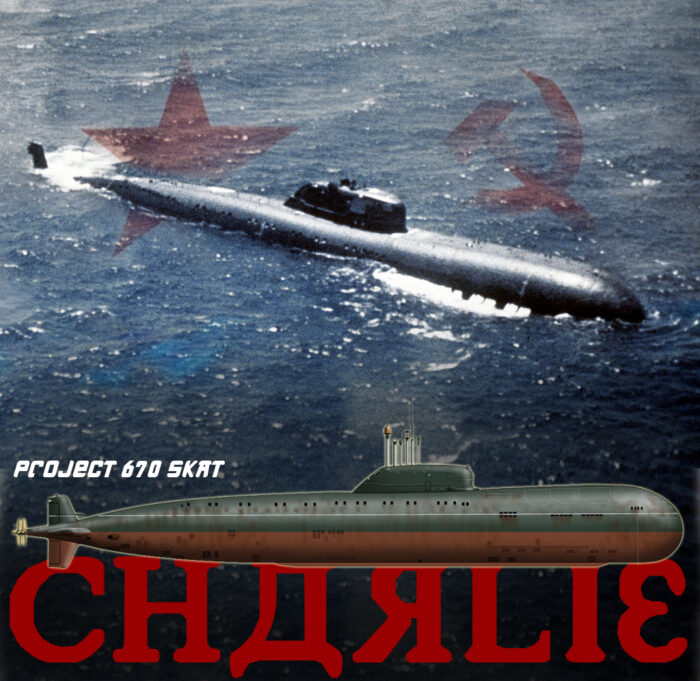
Note: Full logs planned for 2025 if found.
Read More/Src
Books
Hampshire, Edward (2018). Soviet Cruise Missile Submarines of the Cold War. Osprey Publishing
Pavlov, A. S. (1997). Warships of the USSR and Russia 1945–1995. NIP.
Polmar, Norman & Moore, Kenneth J. (2004). Cold War Submarines: The Design and Construction of U.S. and Soviet Submarines. Potomac Books.
Polmar, Norman & Noot, Jurrien (1991). Submarines of the Russian and Soviet Navies, 1718–1990. NIP
Vilches Alarcón, Alejandro A. (2022). From Juliettes to Yasens: Development and Operational History. Europe @ War (22). Helion.
Links
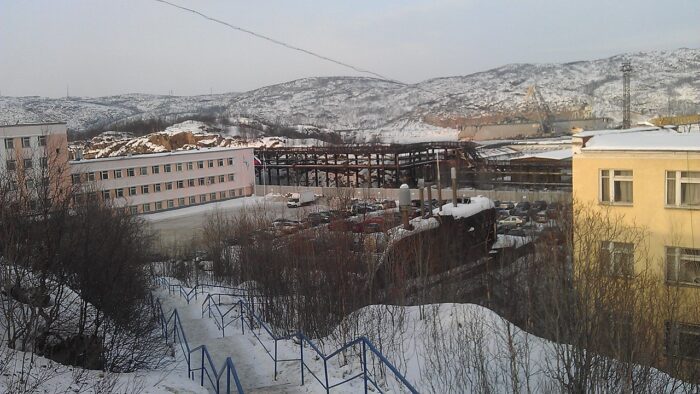
Saved sail now displayed at the Nerpa Plant in 2012 (Panoramio).
deepstorm.ru/ 670/list.htm
deepstorm.ru/ 670m/list.htm
web.archive.org/ submarine.id.ru
nuke.fas.org 670.htm
ship.bsu.by/
web.archive.org/ ruspodlodka.narod.ru/
web.archive.org pilot.strizhi.info/
en.wikipedia.org/ Charlie-class_submarine
en.topwar.ru proekt-670-skat
ru.wikipedia.org/
bellona.org/
web.archive.org/ submarine.id.ru K429.htm
Videos
Model Kits
Main query on scalemates, 1:350 and 1:700 kits

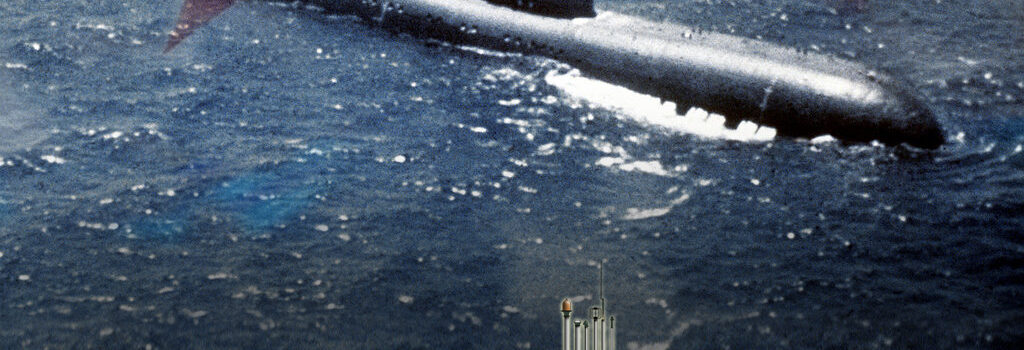
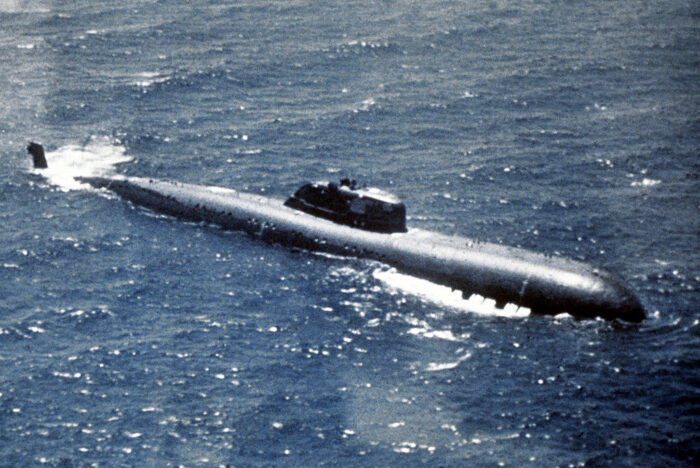
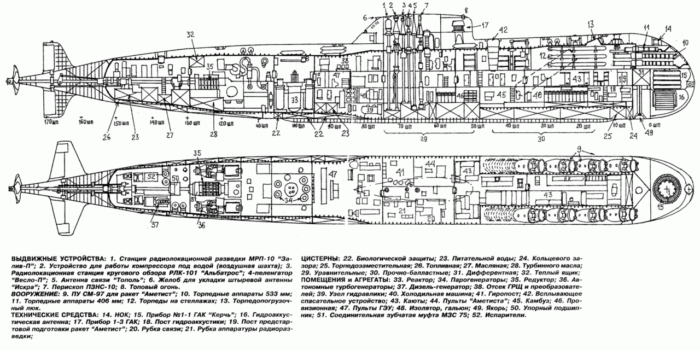
 Latest Facebook Entry -
Latest Facebook Entry -  X(Tweeter) Naval Encyclopedia's deck archive
X(Tweeter) Naval Encyclopedia's deck archive Instagram (@navalencyc)
Instagram (@navalencyc)





 French Navy
French Navy Royal Navy
Royal Navy Russian Navy
Russian Navy Armada Espanola
Armada Espanola Austrian Navy
Austrian Navy K.u.K. Kriegsmarine
K.u.K. Kriegsmarine Dansk Marine
Dansk Marine Nautiko Hellenon
Nautiko Hellenon Koninklije Marine 1870
Koninklije Marine 1870 Marinha do Brasil
Marinha do Brasil Osmanlı Donanması
Osmanlı Donanması Marina Do Peru
Marina Do Peru Marinha do Portugal
Marinha do Portugal Regia Marina 1870
Regia Marina 1870 Nihhon Kaigun 1870
Nihhon Kaigun 1870 Preußische Marine 1870
Preußische Marine 1870 Russkiy Flot 1870
Russkiy Flot 1870 Svenska marinen
Svenska marinen Søværnet
Søværnet Union Navy
Union Navy Confederate Navy
Confederate Navy Armada de Argentina
Armada de Argentina Imperial Chinese Navy
Imperial Chinese Navy Marinha do Portugal
Marinha do Portugal Mexico
Mexico Kaiserliche Marine
Kaiserliche Marine 1898 US Navy
1898 US Navy Sovietskiy Flot
Sovietskiy Flot Royal Canadian Navy
Royal Canadian Navy Royal Australian Navy
Royal Australian Navy RNZN Fleet
RNZN Fleet Chinese Navy 1937
Chinese Navy 1937 Kriegsmarine
Kriegsmarine Chilean Navy
Chilean Navy Danish Navy
Danish Navy Finnish Navy
Finnish Navy Hellenic Navy
Hellenic Navy Polish Navy
Polish Navy Romanian Navy
Romanian Navy Turkish Navy
Turkish Navy Royal Yugoslav Navy
Royal Yugoslav Navy Royal Thai Navy
Royal Thai Navy Minor Navies
Minor Navies Albania
Albania Austria
Austria Belgium
Belgium Columbia
Columbia Costa Rica
Costa Rica Cuba
Cuba Czechoslovakia
Czechoslovakia Dominican Republic
Dominican Republic Haiti
Haiti Hungary
Hungary Honduras
Honduras Estonia
Estonia Iceland
Iceland Eire
Eire Equador
Equador Iran
Iran Iraq
Iraq Latvia
Latvia Liberia
Liberia Lithuania
Lithuania Mandchukuo
Mandchukuo Morocco
Morocco Nicaragua
Nicaragua Persia
Persia San Salvador
San Salvador Sarawak
Sarawak Uruguay
Uruguay Venezuela
Venezuela Zanzibar
Zanzibar Warsaw Pact Navies
Warsaw Pact Navies Bulgaria
Bulgaria Hungary
Hungary

 Bundesmarine
Bundesmarine Dutch Navy
Dutch Navy Hellenic Navy
Hellenic Navy Marina Militare
Marina Militare Yugoslav Navy
Yugoslav Navy Chinese Navy
Chinese Navy Indian Navy
Indian Navy Indonesian Navy
Indonesian Navy JMSDF
JMSDF North Korean Navy
North Korean Navy Pakistani Navy
Pakistani Navy Philippines Navy
Philippines Navy ROKN
ROKN Rep. of Singapore Navy
Rep. of Singapore Navy Taiwanese Navy
Taiwanese Navy IDF Navy
IDF Navy Saudi Navy
Saudi Navy Royal New Zealand Navy
Royal New Zealand Navy Egyptian Navy
Egyptian Navy South African Navy
South African Navy






























 Ukrainian Navy
Ukrainian Navy dbodesign
dbodesign